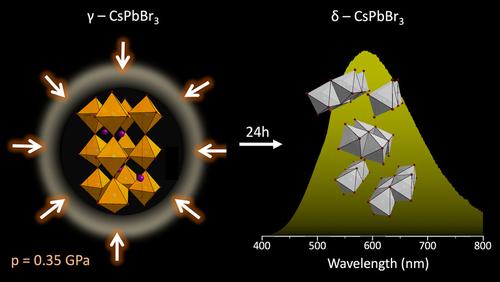当前位置:
X-MOL 学术
›
Helv. Chimica Acta
›
论文详情
Our official English website, www.x-mol.net, welcomes your
feedback! (Note: you will need to create a separate account there.)
Pressure‐Induced Perovskite‐to‐non‐Perovskite Phase Transition in CsPbBr3
Helvetica Chimica Acta ( IF 1.5 ) Pub Date : 2021-01-27 , DOI: 10.1002/hlca.202000222 Agnieszka Noculak 1 , Simon C. Boehme 1 , Marcel Aebli 1 , Yevhen Shynkarenko 1 , Kyle M. McCall 1 , Maksym V Kovalenko 2
Helvetica Chimica Acta ( IF 1.5 ) Pub Date : 2021-01-27 , DOI: 10.1002/hlca.202000222 Agnieszka Noculak 1 , Simon C. Boehme 1 , Marcel Aebli 1 , Yevhen Shynkarenko 1 , Kyle M. McCall 1 , Maksym V Kovalenko 2
Affiliation

|
The expanding range of optoelectronic applications of lead‐halide perovskites requires their production in diverse forms (single crystals, thin‐ and thick‐films or even nanocrystals), motivating the development of diverse materials processing and deposition routes that are specifically suited for these structurally soft, low‐melting semiconductors. Pressure‐assisted deposition of compact pellets or thick‐films are gaining popularity, necessitating studies on the pressure effects on the atomic structure and properties of the resulting material. Herein we report the phase transformation in bulk polycrystalline cesium lead bromide from its three‐dimensional perovskite phase (γ‐CsPbBr3) into the one‐dimensional polymorph (δ‐CsPbBr3) upon application of hydrostatic pressure (0.35 GPa). δ‐CsPbBr3 is characterized by a wide bandgap of 2.9 eV and broadband yellow luminescence at 585 nm (2.1 eV) originating from self‐trapped excitons. The formation of δ‐CsPbBr3 was confirmed and characterized by Raman spectroscopy, 207Pb and 133Cs solid‐state nuclear magnetic resonance, X‐ray diffraction, absorption spectroscopy, and temperature‐dependent and time‐resolved photoluminescence spectroscopy. No such phase transition was observed in colloidal CsPbBr3 nanocrystals.
中文翻译:

CsPbBr3中压力诱导的钙钛矿到非钙钛矿的相变
卤化钙钛矿的光电应用范围不断扩大,要求它们以多种形式生产(单晶体,薄膜和厚膜,甚至纳米晶体),从而推动了多种材料加工和沉积路线的发展,这些路线特别适合于这些结构柔软的材料。 ,低熔点半导体。压密颗粒或厚膜的压力辅助沉积越来越受欢迎,因此有必要研究压力对所得材料的原子结构和性能的影响。本文我们报告在散装的多晶铯溴化铅相变从其三维钙钛矿相(γ-CsPbBr 3)转换成一维的多晶型(δ-CsPbBr 3)施加静水压力(0.35 GPa)时)。δ‐CsPbBr 3的特征是2.9 eV的宽带隙和自捕获的激子在585 nm(2.1 eV)的宽带黄色发光。δ-CsPbBr的形成3确认并且其特征在于拉曼光谱,207 Pb和133 Cs的固态核磁共振,X-射线衍射,吸收光谱,和温度依赖性和时间分辨光致发光光谱。在胶体CsPbBr 3纳米晶体中未观察到这种相变。
更新日期:2021-02-12
中文翻译:

CsPbBr3中压力诱导的钙钛矿到非钙钛矿的相变
卤化钙钛矿的光电应用范围不断扩大,要求它们以多种形式生产(单晶体,薄膜和厚膜,甚至纳米晶体),从而推动了多种材料加工和沉积路线的发展,这些路线特别适合于这些结构柔软的材料。 ,低熔点半导体。压密颗粒或厚膜的压力辅助沉积越来越受欢迎,因此有必要研究压力对所得材料的原子结构和性能的影响。本文我们报告在散装的多晶铯溴化铅相变从其三维钙钛矿相(γ-CsPbBr 3)转换成一维的多晶型(δ-CsPbBr 3)施加静水压力(0.35 GPa)时)。δ‐CsPbBr 3的特征是2.9 eV的宽带隙和自捕获的激子在585 nm(2.1 eV)的宽带黄色发光。δ-CsPbBr的形成3确认并且其特征在于拉曼光谱,207 Pb和133 Cs的固态核磁共振,X-射线衍射,吸收光谱,和温度依赖性和时间分辨光致发光光谱。在胶体CsPbBr 3纳米晶体中未观察到这种相变。











































 京公网安备 11010802027423号
京公网安备 11010802027423号